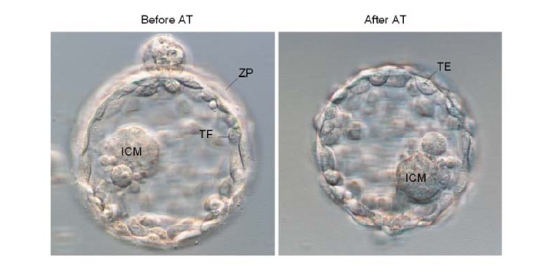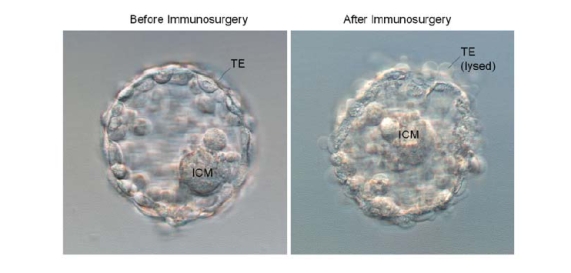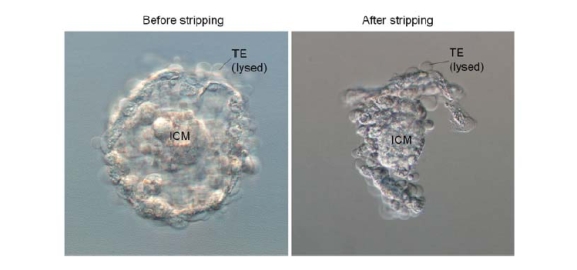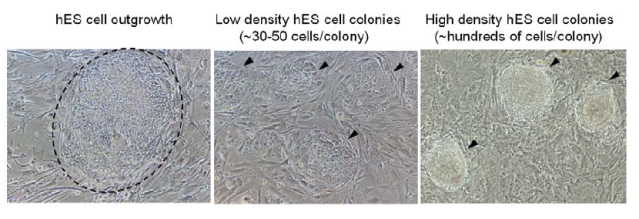Abstract
The ability of human embryonic stem cells to self-renew and differentiate into all cell types of the body suggests that they hold great promise for both medical applications and as a research tool for addressing fundamental questions in development and disease. Here, we provide a concise, step-by-step protocol for the derivation of human embryonic stem cells from embryos by immunosurgical isolation of the inner cell mass.
Protocol
Frozen human embryos used for human embryonic stem (hES) cell derivation were donated for research following proper informed consent under research protocols that were reviewed and approved by both the committee on the use of human subjects and the embryonic stem cell research oversight committee at Harvard University.
Written protocol below is based on published parameters reported by Cowan et al. 2004, with slight modifications.
Embryo Culture
Thaw human embryos using Quinn's Advantage Thaw Kit and culture in drops of Global medium supplemented with 15% Plasmanate until development to the expanded blastocyst stage.
Immunosurgery-based isolation of the inner cell mass
Preparation:
- Prepare plates for removal of the zona pellucida and immunosurgery (see below) by setting up drops of each solution in 10cm plates. Overlay with mineral oil to prevent evaporation. Prepare a single row per embryo intended for derivation.
- EmbryoMax Acidic Tyrodes, use as is.
- hES cell derivation media: 75% KO-DMEM, 10% KO-Serum Replacement, 10% Plasmanate, 2.5% ES cell-tested fetal bovine serum (FBS), 2mM Glutamax-I, 1% non-essential amino acids, 50 units/ml penicillin, 50µg/ml streptomycin, 0.055mM b-mercaptoethanol, 5ng/ml bFGF.
- Rabbit anti-human red blood cell primary antibody, reconstituted according to manufacturer's suggestion, diluted at 1:10 with hES cell derivation media.
- Guinea-pig complement serum, reconstituted according to manufacturer's suggestion, diluted at 1:10 with hES cell derivation media.

Equilibrate all plates to 37°C in tissue culture incubator before use.
Pull 50µl-100µl capillary pipettes (VWR) for use in transferring embryos. Cut ends with diamond pen and use with mouth pipette tubing equipped with a 0.2µm filter.
Immunosurgery Procedure:
Notes:
In this procedure, cells of the trophectoderm are destroyed by brief exposure to antibodies directed against human cells in tandem with complement activity. Therefore, protocol works best with high-quality embryos with an intact trophectoderm, as only the structural integrity of the blastocyst prevents the ICM from also being susceptible to the immunological reaction.
All procedures performed using a dissection scope equipped with heated stage.
Steps:
Rinse mouth pipette to be used for embryo transfer with FBS to prevent embryos from sticking.
Transfer blastocyst from culture dish to hES holding drop of AT dish.
Begin procedure by transferring blastocyst from hES drop through series of AT drops. In third drop, watch for dissolution of zona pellucida (usually 5-30 seconds). Be careful not to over-treat or embryo integrity may be compromised.

Transfer blastocyst through series of hES cell derivation media drops to rinse off AT. Preloading pipette with media is recommended to immediately neutralize AT reaction. Blastocysts can be held here until all have been AT-processed.
Transfer blastocyst through series of primary antibody drops, leaving in third drop for 30 minutes of incubation at 37°C in a tissue culture incubator.
Transfer blastocyst through series of hES cell derivation media drops to rinse off primary.
Transfer blastocyst through series of complement drops, leaving in third drop to watch for lysis of trophectoderm cells. Observe blastocyst for the first 30 seconds on stage for "bubbling" of trophectoderm cells as they lyse. If lysis is observed within this time frame, keep dish on microscope stage to monitor the reaction until completion. If no bubbling is observed during the first 30 seconds, return to incubator, checking every 5 minutes until most of the trophectoderm has lysed. This can take 5-15 minutes. Monitor reaction closely to minimize reaction time and potential damage to the inner cell mass.

Transfer blastocyst through series of hES cell derivation media drops to wash off complement activity.
Using glass pipette with a diameter that is slightly smaller than the blastocyst (pulled from 10µl VWR capillary tubes), draw the blastocyst up and down to strip away most of the lysed trophectoderm.

Plate ICM isolate onto feeder cells of mitotically inactivated mouse embryo fibroblasts (MEFs). MEFs should be prepared the day before derivation and switched to hES cell derivation media day of. 4-well NUNC dishes work well for initial steps of derivation.
Do not disturb plate for first 1-2 days. Thereafter, check daily for outgrowth of embryonic stem cell colonies (usually apparent within 1-2 weeks). Media should be changed in half volumes every other day beginning on day 3.
ES cell outgrowth and passaging
When the hES cell outgrowth has reached approximately 0.5mm or more, it is ready for expansion by mechanical picking.
Mechanically disperse half of the outgrowth and transfer to new plates containing fresh feeders. Embryonic stem cell clumps should be approximately 30-50 cells each. Leave other half of outgrowth as a back-up for the first passage (p1). The outgrowth (p0) can be picked from several times as it continues to expand.

Secondary colonies can be similarly dispersed and expanded across bigger culture dishes until passages 3-5, at which time the new cell lines can be adapted to enzymatic passaging with trypsin. The serum content of the culture media should also be gradually reduced to 1% and 0% during these initial passages to minimize ES cell differentiation.
All established embryonic stem cell lines should be banked by freezing down a portion of early passages for future expansions.
In addition, each cell line should be characterized by karyotype analysis and validated by pluripotency and differentiation studies in vitro and in vivo.
Discussion
The protocol presented here provides researchers with a concise, easy-to-follow outline of how to derive human embryonic stem cell lines by immunosurgical isolation of the inner cell mass.
Acknowledgments
A.E.C. is a fellow of the Jane Coffin Childs Memorial Fund for Medical Research and Merck Research Laboratories. We thank D. Egli and C. Cowan for experimental advice and discussion.
References
- Cowan CA, Klimanskaya I, McMahon J, Atienza J, Whitmyer J, Zucker JP, Wang SP, Morton CC, McMahon AP, Powers D, Melton DA. Derivation of embryonic stem-cell lines from human blastocysts. N ENGL J MED. 2004;350(13):1353–1356. doi: 10.1056/NEJMsr040330. [DOI] [PubMed] [Google Scholar]


